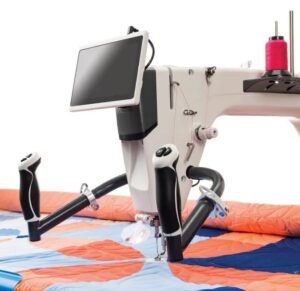Key Takeaways:
- Understanding the importance of a good quality sewing machine for machine quilting is crucial for achieving professional results
- Selecting the right type of quilting needle and thread is essential for ensuring smooth and precise stitching
- Investing in a quilting extension table can greatly improve the ease and accuracy of machine quilting larger projects
- Utilizing quilting gloves can provide better grip and control when maneuvering the fabric during the quilting process
- Learning and practicing different machine quilting techniques, such as stippling and free-motion quilting, can enhance the overall creativity and artistry of your quilting projects
What Do You Need for Machine Quilting?
Choosing the Right Sewing Machine for Machine Quilting
When it comes to machine quilting, having a reliable and high-quality sewing machine is essential for achieving professional results. A good machine should have a large throat space to accommodate the bulk of a quilt and a powerful motor to easily stitch through multiple layers of fabric and batting. Look for a machine with adjustable speed control and a variety of stitch options to cater to different quilting techniques. Additionally, features such as a needle threader, automatic thread cutter, and a walking foot can greatly enhance the quilting experience. Investing in a machine with a sturdy frame and smooth, consistent stitch quality will ensure that your quilting projects turn out beautifully. Finally, regular maintenance and proper cleaning of the machine will prolong its lifespan and keep it running smoothly for years to come.

Needle and Thread Selection for Machine Quilting
When it comes to machine quilting, choosing the appropriate needle and thread is crucial for achieving high-quality results. The type and size of the needle can significantly impact the stitching process, as it determines how the fabric and batting will be penetrated. For quilting, it is recommended to use a sharp needle with a thin shaft, such as a quilting needle, to easily pierce through multiple layers of fabric. Additionally, selecting the right thread for machine quilting is equally important. A high-quality, strong thread that complements the fabric and batting will contribute to smooth and precise stitching. It’s essential to match the thread weight to the needle size for balanced tension and optimal performance. Overall, investing in the proper needle and thread for machine quilting is fundamental for achieving professional-looking quilted projects.
Benefits of Using a Quilting Extension Table
When considering machine quilting, investing in a quilting extension table is a wise decision. These tables provide a larger and more stable surface for maneuvering the quilt, reducing the risk of uneven tension and puckering. They also offer additional support for the weight of the quilt, preventing strain on the machine and ensuring smoother stitching. The extended workspace allows for better control and precision when working on larger quilting projects, making the quilting process more efficient and enjoyable. Furthermore, many extension tables come with handy features such as adjustable height and additional storage, enhancing the overall quilting experience. Overall, a quilting extension table is a valuable addition to any quilter’s toolkit, offering improved ease and accuracy for machine quilting larger projects.
Benefits of Quilting Gloves in Machine Quilting
When engaging in machine quilting, utilizing quilting gloves can significantly enhance the quilting experience. These gloves are designed with a textured surface that provides better grip and control when maneuvering the fabric through the sewing machine. This improved grip not only ensures smoother movement of the fabric but also helps in maintaining a consistent stitch length and pattern. Additionally, quilting gloves reduce hand fatigue and strain, allowing quilters to work for longer periods without discomfort. The enhanced control provided by these gloves is particularly beneficial when working with intricate designs or free-motion quilting, as it allows for more precise and accurate stitching. Overall, investing in quilting gloves is a practical choice for anyone looking to optimize their machine quilting process and achieve professional-looking results.
Enhancing Creativity Through Machine Quilting Techniques
When it comes to machine quilting, learning and practicing different techniques is essential for enhancing the creativity and artistry of your quilting projects. Mastering techniques such as stippling and free-motion quilting can significantly elevate the visual appeal and quality of your quilts. It allows you to add intricate and personalized designs to your quilting projects, making them unique and visually stunning. By honing these skills, you can create quilts that reflect your individual style and artistic vision. Additionally, understanding various machine quilting techniques provides you with the versatility to work on a wide range of quilting projects, from traditional to modern designs. As you become proficient in these techniques, you’ll gain the confidence to experiment with different patterns and styles, leading to a more fulfilling and enriching quilting experience. Ultimately, investing time in learning and practicing machine quilting techniques is a valuable endeavor that can significantly enhance the quality and creativity of your quilting projects.
Techniques and Styles in Computerized Quilting
When it comes to machine quilting, utilizing computerized techniques can significantly enhance the precision and intricacy of quilting designs. Long arm quilting machines offer a wide range of features and capabilities, allowing quilters to explore various styles and techniques. With the integration of NLP (Natural Language Processing) technology, these machines can interpret complex quilting patterns and execute them with remarkable accuracy. Moreover, the use of semantically related terms in quilting software enables quilters to seamlessly translate their creative vision into stunning quilt designs. Longtail keywords play a crucial role in optimizing the machine’s performance, as they help quilters fine-tune their quilting parameters for specific styles and patterns. Whether it’s intricate stippling, precise geometric designs, or elaborate embroidery, computerized quilting machines provide a versatile platform for quilters to explore and master diverse techniques and styles. By leveraging the capabilities of these advanced machines, quilters can elevate their craft and bring their quilting projects to new heights of artistry and sophistication.
Customization and Personalization
When considering machine quilting, customization and personalization are essential aspects to keep in mind. Long arm quilting machines offer the capability to create intricate designs and patterns that cater to individual preferences and styles. With the help of computerized quilting systems, users can employ natural language processing (NLP) to input specific instructions and commands for the machine to execute. This level of customization allows for semantically related terms to be utilized, resulting in a more tailored and unique quilting experience. Additionally, long tail keywords can be incorporated to further enhance the personalization of the quilting process. By leveraging the advanced features of sewing and embroidery machines, enthusiasts can achieve a high degree of customization in their quilting projects, ensuring that each piece reflects their individual creativity and vision.
Ergonomics and User Experience
When considering machine quilting, it’s crucial to prioritize ergonomics and user experience. Investing in a long arm quilting machine with adjustable features can significantly enhance the comfort and efficiency of the quilting process. Additionally, selecting a sewing machine with intuitive controls and ergonomic design can make a notable difference in the overall quilting experience. Embroidery machines with user-friendly interfaces and ergonomic positioning also contribute to a more comfortable and enjoyable quilting journey. By prioritizing ergonomics and user experience in your machine quilting setup, you can reduce the risk of strain or discomfort during extended quilting sessions and optimize your productivity and creativity.
Educational and Training Resources
When it comes to machine quilting, having access to educational and training resources is essential for honing your skills. Utilizing online tutorials, workshops, and webinars can provide valuable insights into the latest techniques and trends in computerized quilting. Additionally, seeking out NLP (Natural Language Processing) tools that offer semantically related terms can help expand your understanding of quilting terminology and concepts. Longtail keywords can also be beneficial in finding specific educational resources tailored to your individual learning needs. Investing time in educational and training resources can significantly enhance your proficiency with long arm quilting machines, sewing machines, and embroidery machines, ultimately leading to more polished and professional quilting projects.
Precision and Complexity in Designs
When it comes to machine quilting, precision and complexity in designs are essential for achieving professional-looking results. Long arm quilting machines are particularly well-suited for handling intricate and detailed patterns with precision. Utilizing computerized quilting software allows for the creation and execution of complex designs, such as feathers, intricate geometric shapes, and fine details. Embroidery machines can also play a crucial role in adding intricate embellishments and details to quilted projects, enhancing the complexity and visual appeal of the final piece. Additionally, sewing machines with advanced stitching capabilities can contribute to achieving precise and intricate quilting designs. Understanding the nuances of NLP and semantically related terms in the context of machine quilting is essential for harnessing the full potential of these technological tools in creating elaborate and precise quilt designs.
Related Searches
- Where do you start when machine quilting?
- Do you need a special foot for machine quilting?
- How many quilts does the average quilter make a year?
- How do you tie off thread when machine quilting?
Video: Choosing Needles and Thread for Machine Quilting and Free Motion Quilting
Video: Beginner Free Motion Quilt tutorial on a home machine 2019
Video: 8 Tips for Choosing Machine Quilting Thread
Frequently Asked Questions
Is there an automatic quilting machine?
Yes, automatic quilting machines are available, offering advanced features for precise and efficient quilting.
What is computerized quilting?
Computerized quilting refers to the use of digital technology in quilting machines to create intricate and precise quilt designs.
What is the best sewing machine to quilt with?
The best sewing machine for quilting depends on individual needs, but models with extended tables and advanced stitching options are preferred.
How much does a longarm quilter cost?
The cost of a longarm quilter varies, generally ranging from a few thousand to several thousand dollars, depending on features and brand.
What is the average cost of having a quilt machine quilted?
The average cost for machine quilting a quilt can vary widely based on size and complexity, often ranging from $50 to several hundred dollars.
What is ultrasonic quilting?
Ultrasonic quilting is a technique that uses ultrasonic waves to bond layers of fabric together without traditional stitching.
Can you quilt without a quilting machine?
Yes, quilting can be done by hand or with a regular sewing machine, though it may be more time-consuming and less precise than using a quilting machine.
What is IQ quilting?
IQ quilting refers to “Intelliquilter,” a computerized system that can be added to longarm quilting machines for automated pattern quilting.
What is the difference between a sewing machine and a quilting machine?
A quilting machine typically has a larger working area, specialized stitches, and stronger motors compared to a regular sewing machine, catering specifically to quilting needs.
What is the easiest quilting machine to use?
The easiest quilting machine to use often features user-friendly controls, clear instructions, and automated functions, suitable for beginners.
Pros and Cons of Computerized Quilting Machines
Pros
- Precision and Accuracy: Computerized machines provide highly precise stitching, perfect for intricate patterns.
- Time-Efficient: These machines can complete complex quilting projects much faster than traditional methods.
- Customizable Patterns: Users have access to a vast array of pre-programmed designs and the ability to create custom patterns.
- Ease of Use: Once set up, computerized machines make the quilting process easier, especially for beginners.
- Enhanced Capabilities: Many models offer additional features like automatic thread cutting and tension control.
Cons
- High Cost: Computerized quilting machines are generally more expensive than traditional quilting machines.
- Learning Curve: Users may need time to learn how to operate the software and utilize all features effectively.
- Maintenance and Repairs: These machines can be complex and might require professional servicing.
- Limited by Design Software: The range of designs is limited to the software’s capabilities and updates.
- Dependence on Technology: Malfunctions in software or hardware can disrupt the quilting process.
